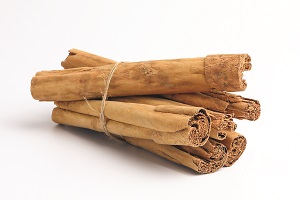
Are you sure that you are using the right Cinnamon?
CINNAMON IS NOT ONLY A SPICE!
Cinnamon is one of the oldest known herbs: obtained from an exotic tree, indigenous to Sri Lanka and Southwest India, it is mentioned in the Bible as well as in Sanskrit, Egyptian, Greek and Roman texts. Its inner bark, after drying and curling into rolls known as “sticks” or “quills”, is mainly used as a spice, especially in Christmas cookies, herbal teas and other winter comfort foods or delicacies. Nevertheless, Cinnamon can claim a very long traditional use, as a tonic, carminative, spasmolytic, eupeptic and antiseptic agent; in Ayurvedic medicine Cinnamon is a major digestive herb, but it is also said to improve circulation, nocturia, arthritis, male impotency and cardiac insufficiency. In recent times the plant has attracted much interest for its ability to lower serum lipids and blood glucose: in a meta-analysis the consumption of Cinnamon was associated with a statistically significant decrease in levels of fasting plasma glucose, total cholesterol, LDL-C, triglycerides levels and an increase of HDL-C levels, while in a recent randomized, placebo controlled clinical trial the intake of 1 g Cinnamon powder for 12 weeks reduced fasting blood glucose and glycosylated Hb among poorly controlled type 2 diabetes patients.
Those benefits have been attributed to cinnamaldehyde and to the polyphenolic fraction, some natural, powerful antioxidants and radical scavengers.
ARE YOU SURE THAT YOU ARE USING THE RIGHT CINNAMON?
The name ‘Cinnamon’ is correctly used to refer to Ceylon Cinnamon, also known as ‘True Cinnamon’ (Cinnamomum verum J. Presl). Despite this, other species are sometimes sold as Cinnamon, i.e. Chinese Cinnamon (Cinnamomum cassia (Nees & T.Nees) J.Presl). The True Cinnamon is considered totally safe, while there is a concern about the Chinese one, especially in case of prolonged use, due to its coumarin content; Chinese Cinnamon is a cheaper alternative to the true spice coming from Sri Lanka and recent studies have proved that most of the Cinnamon powder on the food market is mislabeled and comes from Chinese Cinnamon.
EPO SRL is now launching a Cinnamon extract for the food market, whose botanical species is certified through DNA barcoding test, a technique for characterizing species using a short DNA sequence from a standard part of the genome; the technique is similar to a supermarket scanner, which identifies products by reading black bars of the UPC (Universal Product Code): the sample is identified by finding the closest matching between its isolated DNA sequence and a reference sequence of an official barcode database.
EPO’s True Cinnamon Dry Extract, standardised to contain 25-30% polyphenols, associates the taste and flavour of the powdered spice with safety and health benefits, especially in cardiovascular protection and glycemia control, of a concentrated source, such as an extract.
